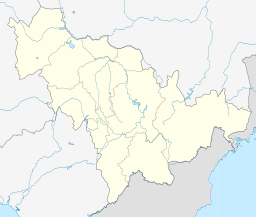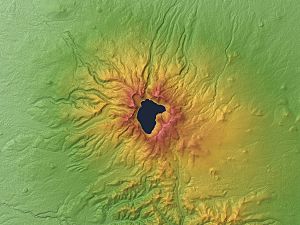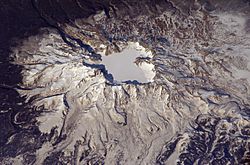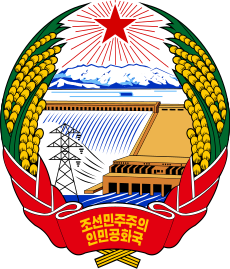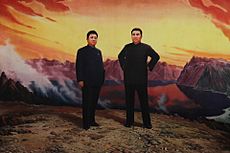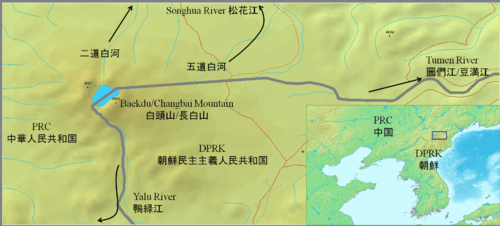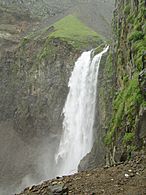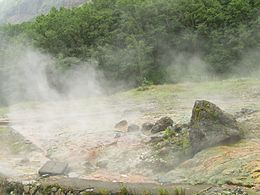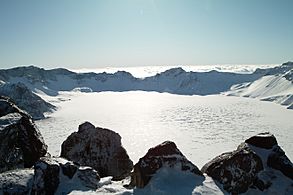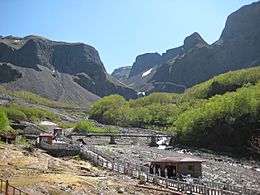Paektu Mountain facts for kids
Quick facts for kids Paektu Mountain |
|
|---|---|
| 백두산 / 白頭山 (Korean) 长白山 (Chinese) |
|
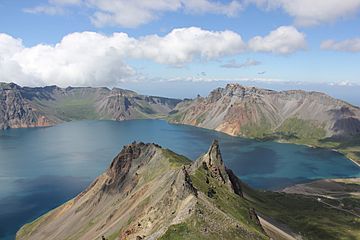
The summit caldera of Paektu Mountain, with Heaven Lake
|
|
| Highest point | |
| Elevation | 2,744 m (9,003 ft) |
| Prominence | 2,593 m (8,507 ft) |
| Listing | Country high point Ultra |
| Geography | |
| Location |
|
| Parent range | Changbai Mountains |
| Geology | |
| Mountain type | Stratovolcano |
| Last eruption | March 1903 |
| Paektu Mountain | |||||||||
|---|---|---|---|---|---|---|---|---|---|
| Chinese name | |||||||||
| Simplified Chinese | 长白山 | ||||||||
| Traditional Chinese | 長白山 | ||||||||
| Literal meaning | ever-white mountain | ||||||||
|
|||||||||
| Korean name | |||||||||
| Chosŏn'gŭl | 백두산 | ||||||||
| Hancha | 白頭山 | ||||||||
| Literal meaning | white head mountain | ||||||||
|
|||||||||
| Chinese Korean name | |||||||||
| Chosŏn'gŭl | 장백산 | ||||||||
| Hancha | 長白山 | ||||||||
| Literal meaning | ever-white mountain | ||||||||
|
|||||||||
| Manchu name | |||||||||
| Manchu script | ᡤᠣᠯᠮᡳᠨ ᡧᠠᠩᡤᡳᠶᠠᠨ ᠠᠯᡳᠨ | ||||||||
| Romanization | Golmin Šanggiyan Alin | ||||||||
Paektu Mountain (Korean: 백두산), also known as Baekdu Mountain, is a huge active mountain. It sits right on the border between China and North Korea. In Chinese, it's called Changbai Mountain (Chinese: 长白山). In the Manchu language, it's known as Golmin Šanggiyan Alin.
Standing at 2,744 meters (about 9,000 feet) tall, it's the highest mountain in both North Korea and Northeast China. It's also the tallest in the Changbai Mountains range. The mountain has a big bowl-shaped area at its top, called a caldera. This caldera holds a beautiful crater lake named Heaven Lake. This lake is also where three important rivers begin: the Songhua, Tumen, and Yalu.
For people in Korea and Manchuria, this mountain and its lake are very special. They believe it's their ancient homeland and has a magical feel to it.
The mountain's caldera was formed by a massive volcanic eruption in 946 AD. This eruption was one of the biggest and most powerful on Earth in the last 5,000 years. The volcano last erupted in 1903. Experts think it might erupt again about every hundred years. In the 2010s, scientists from different countries started studying it closely. They wanted to understand when the next eruption might happen.
Paektu Mountain is very important to the cultures of Korean, Chinese, and Manchu people. It's a huge national symbol for both North and South Korea. You can find it mentioned in their national anthems. It's even shown on the national emblem of North Korea. The Manchu people also see it as their ancestral home. The Chinese Qing emperors saw it as a sign of their power. Over the years, there have been some disagreements about who owns parts of the mountain.
Contents
Mountain Names and Meanings
The mountain has had many names throughout history. One of its first recorded names in Chinese was Bùxián Shān. Later, it was called Tàibái Shān.
The name Chángbái Shān (长白山; 長白山), which means 'ever-white mountain', was first used a long time ago. This name came from the idea that the mountain was "the home of the white-robed Guanyin" and that its animals were all white. The modern Manchu name, golmin šanggiyan alin, also means 'ever-white mountain'.
The modern Korean name, Paektusan or Baekdusan (백두산; 白頭山), means 'white-head mountain'. This name was first written down in the 13th century. Another Korean name, Taebaeksan, means 'great-white mountain'.
Mountain Features and Climate
Paektu Mountain is 2,744 meters (about 9,000 feet) tall. This makes it the highest mountain in North Korea and Northeast China. It's also the highest in the Changbai Mountains range.
Paektu Mountain is a stratovolcano, which is a tall, cone-shaped volcano. The middle part of the mountain rises a little bit each year. This happens because hot, melted rock (magma) is moving underneath it. There are sixteen peaks around the edge of the caldera, all taller than 2,500 meters (about 8,200 feet). The highest peak, Janggun Peak, is covered in snow for about eight months a year.
The caldera is about 5 kilometers (3 miles) wide and 850 meters (2,800 feet) deep. Part of it is filled with the water of Heaven Lake.
Heaven Lake is about 12 to 14 kilometers (7 to 9 miles) around. Its average depth is 213 meters (700 feet), and it can be as deep as 384 meters (1,260 feet). The lake is usually covered with ice from mid-October to mid-June. Water flows out of the lake to the north. Near the outlet, there's a 70-meter (230-foot) tall waterfall. The mountain is where the Songhua, Tumen, and Yalu rivers begin. The Tumen and Yalu rivers form the northern border between North Korea and China.
Mountain Weather
The weather on Paektu Mountain can change very quickly and be quite harsh. The average temperature at the peak for the whole year is about -4.9 degrees Celsius (23.2 degrees Fahrenheit). In summer, temperatures can reach 18 degrees Celsius (64 degrees Fahrenheit) or higher. But in winter, they can drop to -48 degrees Celsius (-54 degrees Fahrenheit). The coldest temperature ever recorded was -51 degrees Celsius (-60 degrees Fahrenheit) in January 1997.
The average temperature in January is about -24 degrees Celsius (-11 degrees Fahrenheit). In July, it's about 10 degrees Celsius (50 degrees Fahrenheit). This means the mountain stays below freezing for eight months of the year. The wind is also very strong, with an average speed of 42 kilometers per hour (26 miles per hour). It can even reach 63 kilometers per hour (39 miles per hour).
Volcanic History
The exact way Paektu Mountain was formed is still a bit of a mystery to scientists. One idea is that it formed over a hot spot in the Earth. Another idea is that it formed where the Pacific Plate is sinking beneath the land.
About 5 million years ago, Paektu Mountain started erupting. These eruptions created a large flat area made of hardened lava. The main cone of the volcano began to grow about 1 million years ago. During this time, there were several very large eruptions that sent ash all the way to the Sea of Japan.
Millennium Eruption
The mountain's caldera, which holds Heaven Lake, was formed in 946 AD. This happened during a huge eruption known as the "Millennium" or "Tianchi" eruption. It was one of the most powerful eruptions in the last 5,000 years. Ash from this eruption has been found as far away as Japan and even Greenland. This massive event destroyed much of the volcano's top, leaving behind the caldera we see today.
According to old Korean records, in 946 AD, loud "thunders from heaven's drum" were heard in the city of Kaesong. This city was about 450 kilometers (280 miles) south of the volcano. The noise was so scary that the king even pardoned prisoners. In Japan, "white ash rain" fell in the city of Nara about three months later. More loud noises were reported in Kyoto, Japan, in February 947.
Recent Volcanic Activity
After the huge Millennium eruption, Paektu Mountain had at least three smaller eruptions. These happened in 1668, 1702, and 1903.
Studying Future Eruptions
In 2011, experts from North and South Korea met to talk about the chance of another big eruption soon. Since the last one was in 1903, and volcanoes like this often erupt about every 100 years, they were concerned. North Korea invited volcanologists (scientists who study volcanoes) from other countries to help. They wanted to study the mountain for recent signs of activity. These scientists started sharing their findings in 2016. In 2020, they even formed the Mt. Paektu Research Center to continue their work.
Plants and Animals
There are five known types of plants that live in Heaven Lake itself. Around the lake's shores, about 168 different plant species have been found. The forest on the Chinese side of the mountain is very old and has not been changed much by humans. Near the tree line, you'll find many Birch trees. Lower down, there are more pine trees mixed with other kinds of trees. On the North Korean side, some of the lower slopes have lost many trees due to deforestation.
The area is home to many wild animals. These include Siberian tigers, bears, wolves, and wild boars. Some types of wild dogs, called Ussuri dholes, might no longer live in the area. Deer that live in the mountain forests are a type of Siberian roe deer. Many wild birds also live here, like black grouse, owls, and woodpeckers. BirdLife International has named the mountain an Important Bird Area (IBA). This is because it's a home for a special kind of duck called the scaly-sided merganser.
Cultural Importance
The people living around Paektu Mountain have always seen it as a sacred place. Many Koreans and Manchus believe it is holy, especially Heaven Lake in its crater.
Importance in Korea
Koreans have always considered Paektu Mountain sacred. According to Korean stories, it's where Dangun, the founder of the ancient kingdom of Gojoseon, was born. His parents were said to be a Son of Heaven and a bear who turned into a woman. Later Korean kingdoms also honored the mountain.
The mountain is mentioned in the national anthems of both North and South Korea. It's also in the famous Korean folk song "Arirang".
During the time when Japan ruled Korea, the thick forests around the mountain were used as hiding places by Korean fighters. Later, during the Korean War, communist fighters also used these areas. Kim Il Sung, a leader of North Korea, organized his fight against the Japanese here. North Korea says that Kim Jong Il, another leader, was born there. However, records outside North Korea suggest he was born in the Soviet Union.
Since 1993, the mountain has been on the state emblem of North Korea. The North Korean Constitution calls it "the sacred mountain of the revolution." North Korean news often talks about special events seen at the mountain as important signs. The mountain's name is used for many products, like the Paektusan rocket and the Paektusan computer.
Importance in China
Mount Changbai was seen as the most sacred mountain in the shamanist religion of the Manchus. The Manchu clan Aisin Gioro, who started the Qing dynasty in China, believed their first ancestor was born near Paektu Mountain. Qing emperors visited the mountain many times to show their respect. They believed the mountain's geography helped prove their right to rule China.
The phrase Baishan Heishui, meaning "white mountain and black river," refers to Mount Changbai and the Heilongjiang. This phrase has been a traditional name for Northeast China for a long time.
Border Disputes
Throughout history, there have been disagreements about the border around Paektu Mountain. In the past, the Yalu and Tumen Rivers were set as borders. In 1712, Chinese and Korean officials surveyed the area and built a monument to mark the boundary near the lake.
In 1909, China and Japan made an agreement about the border. At that time, Korea was under Japanese rule. This agreement said that the north and east parts of the mountain belonged to China.
Recent Border Issues
In the 1960s, China and North Korea secretly made two agreements about their modern borders. These agreements focused on who owned Paektu Mountain and Heaven Lake. Because of these agreements, North Korea received about 280 square kilometers (108 square miles) of land on and around Paektu. They also got 54.5% of Heaven Lake. However, the governments of Taiwan and South Korea do not agree with these treaties.
As of 2013, South Korea officially claims Heaven Lake and the inside part of the mountain ridge. Some groups in South Korea are concerned about China's activities on its side of the border. These activities include building up tourism, holding cultural events, and trying to get the mountain recognized as a World Heritage Site. These groups believe China is trying to claim the mountain as its own. They also don't like China using the name Mount Changbai. Some groups even think the whole mountain belongs to Korea and was given away by North Korea.
During the 2007 Asian Winter Games in China, some South Korean athletes held up signs saying "Mount Paektu is our territory." Chinese officials protested, saying that political messages are not allowed in sports events. The South Korean team apologized.
Visiting Paektu Mountain
Most visitors, including Chinese, South Korean, and international tourists, climb the mountain from the Chinese side. The North Korean side is also popular for people visiting North Korea. The Chinese tourism area is considered a top-rated scenic spot.
On the North Korean side, there are several interesting places. Paektu Spa is a natural hot spring where bottled water comes from. Pegae Hill is a camp site where Kim Il Sung's revolutionary army supposedly stayed when fighting against Japanese rule. Some of these secret camps are now open to the public. There are also several waterfalls, like the Hyongje Falls. In 1992, a large sign with metal letters saying "Holy mountain of the revolution" was put on the mountain. North Koreans say there are 216 steps to the top, symbolizing Kim Jong Il's birthday, February 16. There is also a funicular system (a type of cable car) on the North Korean side.
See also
 In Spanish: Monte Paektu para niños
In Spanish: Monte Paektu para niños
- Geography of North Korea
- Changbai Mountain Range
- Jong-il Peak
- List of mountains in Korea
- List of volcanoes in Korea
- List of volcanoes in China
- Geography of China
- Sacred mountains




